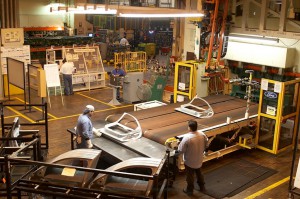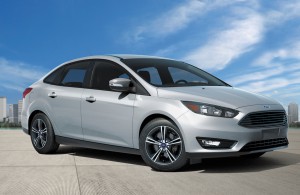
Ford had planned to shift production of the Focus to Hermosillo, Mexico, but instead will produce it in China.
In a surprise move, Ford Motor Co. says it won’t move production of its Focus model to Mexico., but rather Ford plans to move it to China.
That would make the Ford Focus the first mainstream model to be imported from China, a move that could also raise the ire of President Donald Trump, who has been pressing the auto industry to bring more production – and jobs – back to the U.S.
But with sales of the compact vehicle line sliding sharply, Joe Hinrichs, Ford President of Global Operations, said the move will save the carmaker about $500 million. Ford had already said it would save at least $500 million by scrubbing plans to build an entirely new Mexican plant for the Focus and other small car lines.
Automakers, in general, have been struggling to figure out what to do with small car production as American buyers by the millions shift from sedans and coupes to SUVs and crossover-utility vehicles. Ford announced early in 2016 it would pull the Focus out of a suburban Detroit plant and replace it with a new version of the old Bronco SUV, as well as an all-new version of its midsize Ranger pickup.
(Slowing auto industry threatening to drag down U.S. economy. Click Here for the story.)
The initial plan was to open a second assembly plant in Mexico for Focus and other Ford small cars, a move that quickly drew the wrath of then-candidate Trump. He blasted Ford for cutting American jobs – even though the maker said the Wayne, Michigan plant would actually boost employment for the new truck models – and threatened to impose a hefty border tax.
In January of this year, Ford said it was killing off the plans for a second plant in Mexico and would consolidate production of the Focus in an existing facility in Hermosillo. At the time, Hinrichs told TheDetroitBureau.com the move had nothing to do with the then-new president, the decision being made prior to the November 2016 election.
The latest announcement reflects the continuing decline in Focus sales, which tumbled 20% in May alone, said analyst Dave Sullivan, of AutoPacific, Inc. Noting that the reputation of the compact Focus model was “ruined” by quality problems, Sullivan said, “It has dwindled down to being nothing more than a fleet car.”
Why Ford is moving Focus to China is somewhat unclear, but appears to reflect the fact that the model is already produced there for the Asian region and some other markets. While it could also have consolidated production into Europe, Chinese plants have much lower labor costs – which will offset higher shipping costs, according to Joe Phillippi, an industry consultant with AutoTrends Consulting.
By consolidating the Focus to China, Ford frees up capital and will save $500 million in the long run according to Hinrichs, who was recently promoted from a post heading operations in the Americas.
(Click Here for more about Ford cutting 1,400 jobs.)
The move announced Tuesday raises several immediate questions, including the possibility of a backlash by President Trump, who has continued to put a spotlight on the auto industry. Ford may have softened the impact of the Focus decision by also announcing plans to invest $900 million in its Kentucky plant to expand production of the Ford Expedition and Lincoln Navigator SUVs.
The other issue is how U.S. consumers might react. Chinese automakers have repeatedly promised to enter the American market over the past decade, but have just as frequently scrubbed their plans. Industry analysts have warned that domestic Chinese brands have yet to reach the quality levels Americans would be willing to accept.
But the first Chinese products have quietly arrived bearing Western brand names. Volvo was first with the Inscription, a stretch version of the S60 sedan. Next came Buick, which last year began importing the Chinese-made Envision crossover. General Motors is also bringing over a small number of plug-in hybrid Cadillac CT6 sedans from a plant in Shanghai.
(To see more about how Detroit’s Big Three are dealing with adapting to a global market, Click Here.)
For his part, Ford’s Hinrichs said he doesn’t believe Americans worry about where a vehicle is built as long as it meets other expectations for price and quality.


Perfect. Thanks Trump, you really did a bang up job of stopping Ford from exporting manufacturing to Mexico. Pretty soon companies won’t need to make anything but the most expensive cars since no one but rich investors will be able to buy one because all jobs will be more cheaply done offshore.
I’m not sure if Trump will get mad as some of his interests are over there, and not sure if Ivanka’s lines are still from there as well. I know she was shopping to move lines to Africa / EMEA.
Honestly I believe it was more of a Mexico thing as he was wall-shopping and that was a big, or as he says “BIGLY”, part of his campaign. He couldn’t run an anti-Mexico campaign and have the Big Three + One move jobs there; even his base would say something about that.